On a VMware ESXi server, you can create a new VM and install a guest OS on the VM using a CD or DVD.
For this, you need physical access to the server to insert the installation CD or DVD, which might not be possible, if the server is in a remote datacenter.
The quick and easy way is to upload the OS ISO image to VMware datastore, and use that image to install OS on a new VM.
The advantage of this method is that you don’t need physical access to the VMware ESXi server.
This tutorial explains how to upload ISO image, and use that to install guest OS on a new VMware VM.
If you are new to VMware, read this tutorial: VMware Virtualization Fundamentals – VMware Server and VMware ESXi
Select a Datastore
If you have VMware ESXi servers running in your IT infrastructure, you should first Install VMware vSphere on your local machine, which is required to manage the remote VMware ESXi server.
First, login to your VMware vSphere client, and from the left side panel, click on the ip-address of the resource pool at the top. If you expand this ip-address, you’ll see all existing individual VMs. Don’t click on the individual VM, instead click on the top-level which has the ip-address as shown below.
Next, select the “Configuration” Tab on the right panel. Now, under the hardware section, select “Storage”.
This will display all the datastores available on this VMware server as shown below.
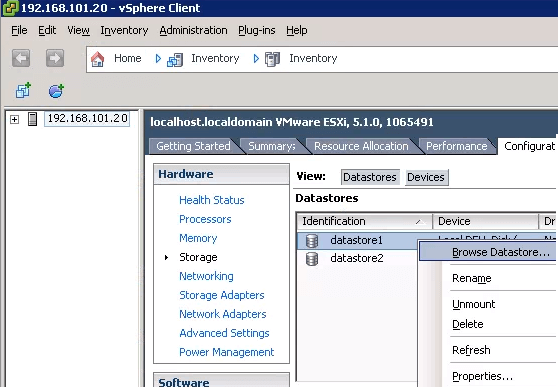
From here, select a datastore where you want to upload your ISO image. You can select any datastore from this list, which has enough free space to store the ISO image that we are going to upload.
Once a datastore is selected, right-click and select “Browse Datastore” as shown in the previous picture.
In this example, we have selected “datastore1”.
Datastore Browser
This will launch the datastore browser as shown below. Select the “Upload” icon on the top toolbar in this browser.
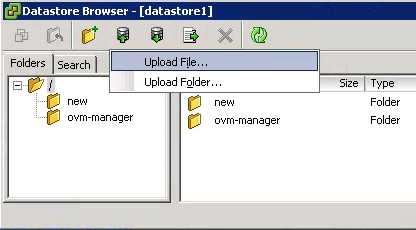
This will display two options: 1) Upload File 2) Upload Folder. Select “Upload File” as shown above.
This will give a warning message indicating that if the file already exists, it will be overwritten, click “Ok” for this.
Upload Linux ISO File to DataStore
From vSphere, select the ISO image that is located on your local machine. This ISO image will be uploaded to the ESXi datastore.
In this example, I want to install CentOS 7. So, I downloaded the CentOS 7 ISO image to my local machine. I will select this ISO image, and upload it to the datastore as shown below.
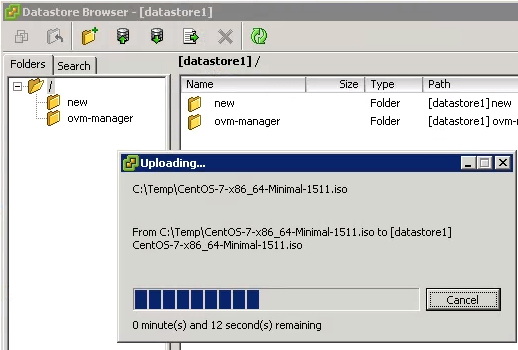
Once the ISO image is uploaded, you’ll see it listed in the datastore browser.
Create New VM
Next, from the vSphere, create a new VM. To create a new VM follow this instruction: How to Create Virtual Machine from vSphere
Follow the above instruction, and perform all the steps until step#7.
Until this point, we have only created a empty VM template and have not yet installed guest OS.
Select VM Properties
Next, select the new VM that you’ve created, and go to “Summary” tab, and click on “Edit Settings” from the Commands panel. This will display the Virtual Machine Properties as shown below.
Select the “CD/DVD Drive 1”, on the Device Type, this will have the “Host Device” radio button selected as shown below. The value in this host device will display the CDROM. This indicates that currently CD/DVD Drive is the selected media for installation of new Guest OS.
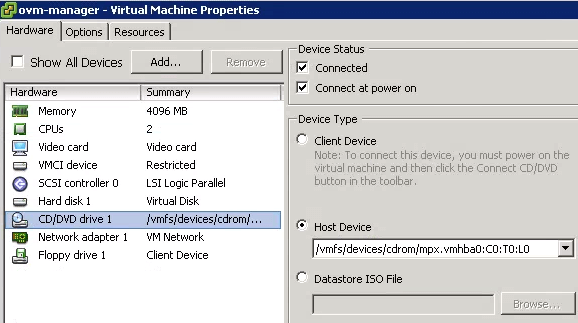
Select ISO Install Image for VM
Now, under the Device Type, select the “Datastore ISO File” radio button, and click on “Browse”, and select the datastore where you uploaded the ISO image.
In this example, I’ll select “datastore1”, as I uploaded the CentOS7 installation ISO file to that datastore.
This will display the ISO image that we earlier uploaded to the Datastore. Select the ISO image and click OK as shown below.
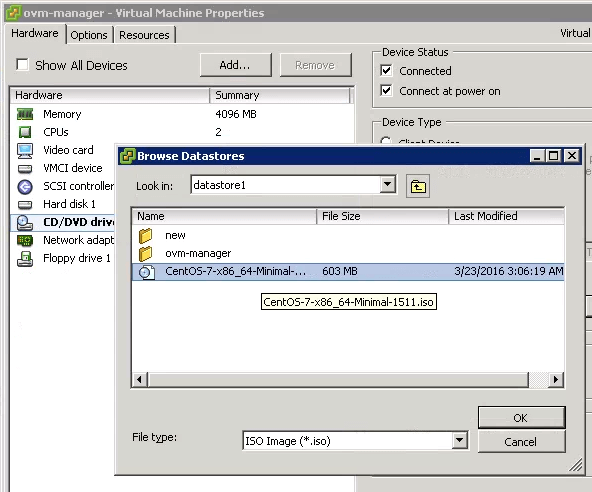
Launch OS Installer from the ISO File
After the above change, in the new VM Properties, we’ll see “CD/DVD Drive1” says “edited”, and this will also show that we are now using the “Datastore ISO File”, and will display the name of the selected ISO file as shown below.
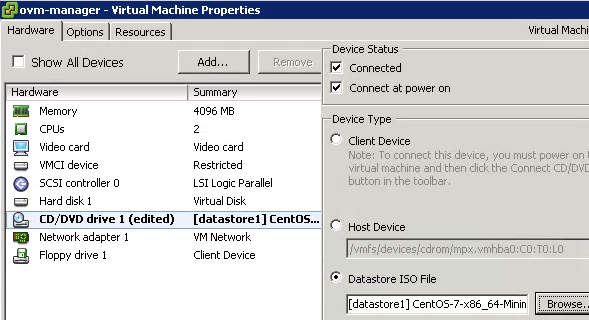
Finally, select the VM, and click on Power-Off and Power-On, which will restart the VM.
Click on the “Console” tab, which will now display the CentOS 7 installation screen, as it is now launching the ISO image of the CentOS 7 installation from the datastore.






 My name is Ramesh Natarajan. I will be posting instruction guides, how-to, troubleshooting tips and tricks on Linux, database, hardware, security and web. My focus is to write articles that will either teach you or help you resolve a problem. Read more about
My name is Ramesh Natarajan. I will be posting instruction guides, how-to, troubleshooting tips and tricks on Linux, database, hardware, security and web. My focus is to write articles that will either teach you or help you resolve a problem. Read more about
Comments on this entry are closed.
“click on the ip-address of the resource pool at the top.”
Resource pools do not have IP address. They have name. Resource Pool is a way to control resource allocation to VMs by away of limits and shares.
Also, real world uses FQDN of the host to add it to vCenter. To create a new VM, you can right click on a
1) Datacenter
2) Cluster
3) Resource Pool
4) Host
and select “New Virtual Machine”
“First, login to your VMware vSphere client”
You don’t login to your vSphere client. You use your vSphere client to login to a vCenter or directly to an ESXi host.
From the screenshot, I can see you login to the host.
Can I assume thats using Windows as the host OS? In my cloud computing class, in EPIC fasion, I failed to install vSPehere6 EXSi data server, on Ubuntu. I eventually attempting so many different changes in the implementation the potential host system crashed and I lost more than 50,000 lines of code, and 75 Gb’s of unbacked up (or sparsley backed up data)
I widh you had this 4 weeks ago I would of had time to pick your brain
GeoWade, ESXi is bare metal Hypervisor. It is installed directly on the physical server. For testing and lab purpose, it can be installed on top of hosted virtualization like VMware Workstation or on top of ESXi itself. This is called Nested Virtualization.
Hi,
Thanks for sharing.
We can also install the OS without uploading the image to local store, but from your desktop itself, thus saving storage on local disk.
Here is the procedure..
1. Right click on VM > Edit settings > Options > Boot options > Tick Force BIOS setup
2. Power on the VM and change the boot order CDROM being the first & save the settings, no reboot yet.
3. Now click on the CD icon and click “Connect to ISO image on Local disk”
4. Browse your desktop folder and Select the image
5. Now reboot the VM
hey,
in step 4 of the VM creation also we are specifying the OS. what is that doing/contributing to the vm? what if is selected windows in step 4 of vm creation and mounted centos from data store to cd drive?
thanks in advance 🙂